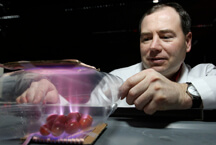
| RELATED INFO |
| * Boiler Bytes |

March 2, 2009
Simple device can ensure food gets to the store bacteria free
WEST LAFAYETTE, Ind. - |
Kevin Keener designed a device consisting of a set of high-voltage coils attached to a small transformer that generates a room-temperature plasma field inside a package, ionizing the gases inside. The process kills harmful bacteria such as E. coli and salmonella, which have caused major public health concerns.
Keener's process is outlined in an article released online early in LWT - Food Science and Technology, a journal for the Swiss Society of Food and Technology and the International Union of Food Science and Technology.
"Conceptually, we can put any kind of packaged food we want in there," said Keener, an associate professor in the Department of Food Science. "So far, it has worked on spinach and tomatoes, but it could work on any type of produce or other food."
By placing two high-voltage, low-watt coils on the outside of a sealed food package, a plasma field is formed. In the plasma field, which is a charged cloud of gas, oxygen has been ionized and turned into ozone. Treatment times range from 30 seconds to about five minutes, Keener said.
Ozone kills bacteria such as E. coli and salmonella. The longer the gas in the package remains ionized, the more bacteria that are killed. Eventually, the ionized gas will revert back to its original composition.
The process uses only 30-40 watts of electricity, less than most incandescent light bulbs. The outside of the container only increases a few degrees in temperature, so its contents are not cooked or otherwise altered.
Other methods of ozone treatment require adding devices to bags before sealing them to create ozone or pumping ozone into a bag and then sealing it. Keener's method creates the ozone in the already sealed package, eliminating any opportunity for contaminants to enter while ozone is created.
"It's kind of like charging a battery. We're charging that sample," Keener said. "We're doing it without electrode intrusion. We're not sticking a probe in the package. We can do this in a sealed package."
Keener said testing has worked with glass containers, flexible plastic-like food-storage bags and rigid plastics, such as strawberry cartons and pill bottles. He said the technology also could work to ensure pharmaceuticals are free from bacteria.
According to the Centers for Disease Control and Prevention, about 40,000 cases of Salmonellosis, an infection caused by salmonella, are reported each year in the United States, causing 400 deaths. The CDC reports that about 70,000 E. coli infections are reported each year, causing dozens of deaths.
Funding for Keener's research came from Purdue Agriculture. A patent on the technology is pending.
Keener said the next step is to develop a commercial prototype of the device that could work on large quantities of food.
Writer: Brian Wallheimer, (765) 496-2050, bwallhei@purdue.edu
Source: Kevin Keener, (765) 494-6648, kkeener@purdue.edu
Ag Communications: (765) 494-2722;
Beth Forbes, forbes@purdue.edu
Agriculture News Page
PHOTO CAPTION:
Kevin Keener’s in-bag ozonation method creates ozone in packaged foods by using high-voltage coils to charge the gas inside sealed food packages, effectively killing any bacteria inside them. In this demonstration with a bag of tomatoes, helium has been added to a plastic bag because it glows, showing the ionization process. (Purdue Agricultural Communication photo/Tom Campbell)
A publication-quality photo is available at https://www.purdue.edu/uns/images/+2009/keener-ozonation.jpg
Safety and Quality of Packaged Spinach Treated
with a Novel Ozone-generation System
Paul A. Klockow and Kevin M. Keener
The quality and safety of packaged salad are major concerns to consumers. Ozone gas is a non-thermal processing technology capable of treating food to reduce pathogens. The ozone generation system (PK-1) used in this study consisted of a pair of electrodes with an adjustable gap inside a package. Individual, fresh, prepackaged, whole spinach leaves inoculated with Escherichia coli O157:H7 646071 were treated in packaging with ozone generated in air and oxygen. Samples were treated for 5-min and stored at room temperature (22°C) or refrigeration (5°C) for 0.5, 2, and 24 h. Gas composition and relative humidity were measured. All treated samples showed reductions in E. coli O157:H7 populations with the largest reductions (3-5 log10 CFU/leaf) after 24 h of storage. After 5-min of treatment, ozone concentrations were 1.6 and 4.3 mg/L for air and oxygen gas, respectively. The concentrations of ozone decreased with time and were not detectable after 24 h. A 5-point Spinach Color Quality (SCQ) scale was established (5-best, 1-worst). Treated spinach showed discoloration with SCQ values of 3.83 and 1.00 for air and oxygen gas exposed leaves after 24 h. These results indicate that the PK-1 system is capable of reducing E. coli O157:H7 in packaged spinach; however, minimizing quality changes after treatment requires further research.
To the News Service home page
If you have trouble accessing this page because of a disability, please contact Purdue News Service at purduenews@purdue.edu.
